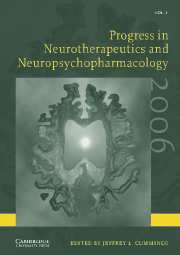Book contents
- Frontmatter
- Contents
- Preface
- Contributors
- Introduction to neurotherapeutics and neuropsychopharmacology
- Rivastigmine in the treatment of dementia associated with Parkinson's disease: a randomized, double-blind, placebo-controlled study
- Modafinil for the treatment of fatigue in multiple sclerosis
- Radiotherapy with concurrent and adjuvant temozolomide: a new standard of care for glioblastoma multiforme
- Treating migraine attacks ASAP: concept and methodological issues
- Early phase trials of minocycline in amyotrophic lateral sclerosis
- Creatine as a potential treatment for amyotrophic lateral sclerosis
- AVP-923 as a novel treatment for pseudobulbar affect in ALS
- Liquid fluoxetine versus placebo for repetitive behaviors in childhood autism
- Testing multiple novel mechanisms for treating schizophrenia in a single trial
- Selegiline in the treatment of negative symptoms of schizophrenia
- Analysis of the cognitive enhancing effects of modafinil in schizophrenia
- Efficacy and tolerability of ziprasidone and olanzapine in acutely ill inpatients with schizophrenia or schizoaffective disorder: results of a double-blind, six-week study, with a six-month, double-blind, continuation phase
- Subject index
- Author index
Efficacy and tolerability of ziprasidone and olanzapine in acutely ill inpatients with schizophrenia or schizoaffective disorder: results of a double-blind, six-week study, with a six-month, double-blind, continuation phase
Published online by Cambridge University Press: 22 March 2010
- Frontmatter
- Contents
- Preface
- Contributors
- Introduction to neurotherapeutics and neuropsychopharmacology
- Rivastigmine in the treatment of dementia associated with Parkinson's disease: a randomized, double-blind, placebo-controlled study
- Modafinil for the treatment of fatigue in multiple sclerosis
- Radiotherapy with concurrent and adjuvant temozolomide: a new standard of care for glioblastoma multiforme
- Treating migraine attacks ASAP: concept and methodological issues
- Early phase trials of minocycline in amyotrophic lateral sclerosis
- Creatine as a potential treatment for amyotrophic lateral sclerosis
- AVP-923 as a novel treatment for pseudobulbar affect in ALS
- Liquid fluoxetine versus placebo for repetitive behaviors in childhood autism
- Testing multiple novel mechanisms for treating schizophrenia in a single trial
- Selegiline in the treatment of negative symptoms of schizophrenia
- Analysis of the cognitive enhancing effects of modafinil in schizophrenia
- Efficacy and tolerability of ziprasidone and olanzapine in acutely ill inpatients with schizophrenia or schizoaffective disorder: results of a double-blind, six-week study, with a six-month, double-blind, continuation phase
- Subject index
- Author index
Summary
Key words: Olanzapine; zisprasidone; schizophrenia; schizoaffective disorders; clinical trial; neurotherapeutics.
Introduction and Overview
Randomized, double-blind, head-to-head trials comparing the efficacy and safety of two atypical antipsychotics continue to be relatively uncommon, though they provide data which are the most readily generalizable to decision-making in clinical practice. Approximately 20 head-to-head trials have been published to date, with the majority reporting comparisons among three atypical drugs: clozapine, risperidone, and olanzapine (Cochrane group, 2005; Tuunainen et al., 2002). Few published comparator studies report data beyond 8 weeks of treatment. The results of available head-to-head trials have generally found minimal between-drug differences in efficacy. Instead, salient differences have been identified primarily in tolerability and safety outcomes.
The chronicity of schizophrenia and schizoaffective disorder, and the need for long-term therapy, make the safety and tolerability of antipsychotic drugs a central concern, both in terms of impact on compliance, and impact on longitudinal health outcomes. This is especially true since schizophrenia is associated with a 2–3-fold increase in all-cause mortality risk, with much of the 20% overall reduction in average life expectancy contributed by increased risk of cardiovascular (CV) and cerebrovascular mortality (Joukamaa et al., 2001; Harris & Barraclough, 1998). Schizophrenic patients appear to be a metabolically vulnerable population, with a significantly higher prevalence of CV risk factors such as obesity, diabetes, and dyslipidemia (Casey et al., 2004; Ryan et al., 2003; Davidson et al., 2001).
- Type
- Chapter
- Information
- Progress in Neurotherapeutics and Neuropsychopharmacology , pp. 149 - 164Publisher: Cambridge University PressPrint publication year: 2006
- 1
- Cited by

